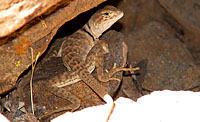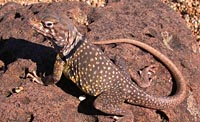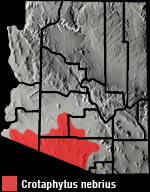Online Field Guide to The Reptiles and Amphibians of Arizona


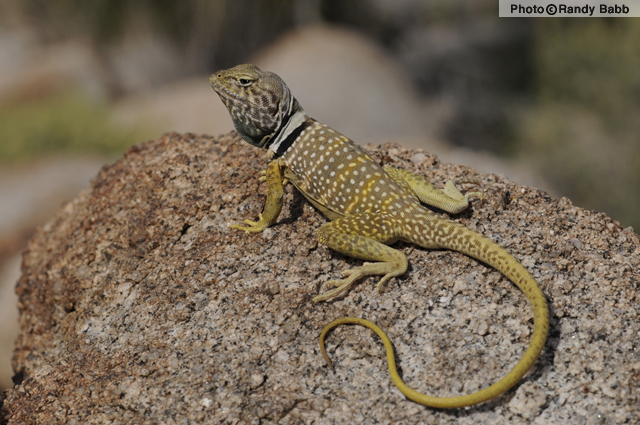
Male. Yuma County, AZ
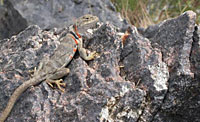 Female. Arizona |
||
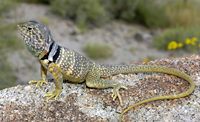 Male, Yuma Co., AZ |
| SONORAN COLLARED LIZARD Crotaphytus nebrius | |
|
DESCRIPTION: A medium-sized (up to 108 mm or 4.25″ from snout to vent), plump-bodied lizard with a large head and two distinct, black collar markings on the neck. The collar is often broken mid-dorsally. On males the front collar completely crosses the neck. Coloration is usually gray-brown often with very faint, soft-edged, yellow-orange crossbands. The back, tail and upper surfaces of the hind limbs ar often marked with light dots. The dots are larger on the top of the back and become small on the sides. The underside is plain and pale. The scales are small and granular. The tail is round in cross section distinguishing this lizard from the similar Great Basin Collared Lizard. Females are duller, often lack light spots, and have orange markings on the neck and sides when gravid. HABITAT: In Arizona this lizard’s range is entirely within the Sonoran Desertscrub community. It frequents rocky bajadas, hillsides, canyons, and mountain slopes. Usually found in areas with numerous large rocks and boulders which are used for basking spots and lookouts. BEHAVIOR: Primarily diurnal. Occasionally evening-crepuscular. It is often seen basking atop large rocks or boulders in the mid-morning sun. It hibernates during the cold months of winter and late fall. At top speeds this lizard lifts the forelimbs off the ground and runs on its hind limbs. Like other collared lizards it is territorial and aggressive to other males. It does not hesitate to bite when captured and it can easily draw blood with its powerful jaws. Unlike many of our lizards collared lizards can not cast off and regenerate the tail. DIET: It uses its powerful jaws to capture a variety of insects, spiders, and small lizards. REPRODUCTION: The Sonoran Collared Lizard lays eggs in spring or summer. By Thomas C. Brennan Brennan, T. C., & A. T. Holycross. 2006. A Field Guide to Amphibians and Reptiles in Arizona. Arizona Game and Fish Department. Phoenix, AZ Brennan, T. C., & A. T. Holycross. 2005. A Field Guide to Amphibians and Reptiles of Maricopa County. Arizona Game and Fish Department. Phoenix, AZ |
|
Visit Partners in Amphibian and Reptile Conservation:


HOME
Copyright © 2023, Arizona Game and Fish Department. All rights reserved.
If you make use of the textual contents of this site in reports, publications, etc. please cite and credit the author(s) and photographer(s). All photos on this website are copyrighted. However, those found in the species account section may be used for any noncommercial scientific, educational, or conservation purposes provided that photographs are not altered and continue to bear the copyright symbol and name of the photographer. Please contact the photographer regarding commercial use of copyrighted photographs.










